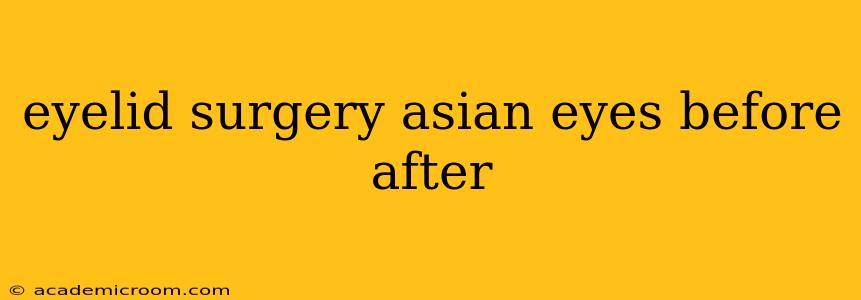Eyelid surgery, or blepharoplasty, is a popular procedure that can dramatically alter the appearance of the eyes. For individuals of Asian descent, this surgery often focuses on addressing the unique features of Asian eyelids, which typically lack a visible crease. This comprehensive guide explores the before-and-after aspects of eyelid surgery for Asian eyes, addressing common questions and concerns.
What Does Eyelid Surgery for Asian Eyes Involve?
Asian eyelid surgery, sometimes called Asian blepharoplasty, aims to create a more defined crease in the upper eyelid. The procedure involves removing excess skin and fat, and sometimes muscle, to achieve a more Westernized look or simply to create a more open and defined eye appearance. There are various techniques used, including:
- Crease Creation: This is the most common goal. Surgeons create a new crease by carefully removing or repositioning tissues.
- Excess Skin Removal: Extra skin is often removed to reduce hooded eyelids, improving visibility and reducing a tired appearance.
- Fat Removal: Excess fat pads can contribute to a puffy or swollen appearance. Careful removal can lead to a more refined look.
- Ptosis Correction: In some cases, eyelid surgery also corrects ptosis (drooping of the upper eyelid).
What are the Benefits of Eyelid Surgery for Asian Eyes?
Many individuals undergo this procedure to enhance their aesthetic appearance. However, the benefits can extend beyond just cosmetic improvement:
- Enhanced Eye Shape: Creates a more defined and Westernized crease in the eyelid, which some individuals prefer.
- Improved Vision: In cases of ptosis, the surgery can improve vision by lifting the drooping eyelid.
- Increased Confidence: A more aesthetically pleasing appearance can boost self-esteem and confidence.
- Youthful Appearance: Removal of excess skin and fat can result in a more youthful appearance.
What are the Risks and Side Effects of Asian Blepharoplasty?
While generally safe, all surgical procedures carry risks. Potential side effects of eyelid surgery include:
- Swelling and Bruising: This is common and usually resolves within a few weeks.
- Infection: Proper post-operative care is crucial to minimize this risk.
- Asymmetry: Slight asymmetries can sometimes occur, though skilled surgeons aim to minimize this possibility.
- Scarring: While incisions are usually small and placed discreetly, some scarring may be present.
- Dry Eyes: Temporary dry eye is possible.
- Unsatisfactory Results: In rare cases, the outcome may not meet the patient's expectations.
How Long is the Recovery Time?
Recovery time varies depending on the extent of the surgery and individual healing abilities. However, most patients can expect:
- Swelling and Bruising: These typically subside within 1-2 weeks.
- Stitches Removal: Usually around 5-7 days post-op.
- Return to Normal Activities: Most can resume normal activities within 2-3 weeks.
- Full Healing: It can take several months for the final results to fully appear.
What is the Cost of Eyelid Surgery for Asian Eyes?
The cost of eyelid surgery varies depending on several factors, including the surgeon's fees, location, and the complexity of the procedure. It's essential to get multiple quotes from different surgeons to understand the price range in your area.
How to Choose a Surgeon for Asian Blepharoplasty?
Selecting the right surgeon is crucial for achieving safe and satisfactory results. Consider these factors:
- Experience with Asian Blepharoplasty: Ensure the surgeon has extensive experience with this specific procedure.
- Board Certification: Choose a board-certified plastic surgeon.
- Before-and-After Photos: Review the surgeon's before-and-after photos to gauge their skill and aesthetic style.
- Consultations: Attend several consultations to ask questions and feel comfortable with the surgeon.
Are There Non-Surgical Options for Achieving Similar Results?
While eyelid surgery offers the most dramatic and permanent results, non-surgical options exist:
- Botox: Can temporarily lift the brows, creating a more open appearance.
- Fillers: Can temporarily address hollowness or puffiness under the eyes.
Can Eyelid Surgery Correct Ptosis?
Yes, if the drooping eyelid (ptosis) is caused by excess skin and tissue, eyelid surgery can successfully correct this issue and improve vision. However, other causes of ptosis may require different treatments.
What's the Difference Between Double and Non-Double Eyelid Surgery?
"Double eyelid surgery" refers to the creation of a visible crease in the eyelid, mimicking a Western eye shape. "Non-double eyelid surgery" may involve other adjustments like removing excess skin or fat, but does not focus on crease creation. The choice depends entirely on the individual's preferences and goals.
This information is for general knowledge and does not constitute medical advice. Always consult with a qualified plastic surgeon to determine if eyelid surgery is right for you and to discuss the risks and benefits specific to your individual case.
